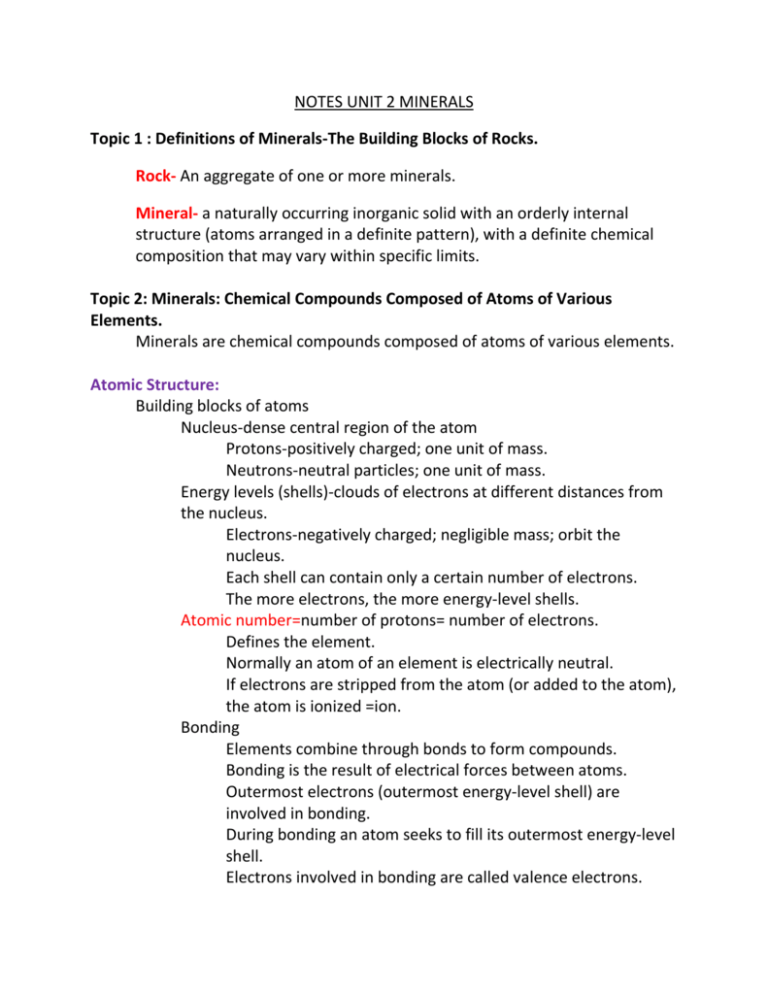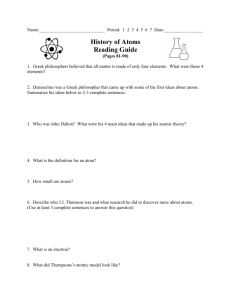File
advertisement

NOTES UNIT 2 MINERALS Topic 1 : Definitions of Minerals-The Building Blocks of Rocks. Rock- An aggregate of one or more minerals. Mineral- a naturally occurring inorganic solid with an orderly internal structure (atoms arranged in a definite pattern), with a definite chemical composition that may vary within specific limits. Topic 2: Minerals: Chemical Compounds Composed of Atoms of Various Elements. Minerals are chemical compounds composed of atoms of various elements. Atomic Structure: Building blocks of atoms Nucleus-dense central region of the atom Protons-positively charged; one unit of mass. Neutrons-neutral particles; one unit of mass. Energy levels (shells)-clouds of electrons at different distances from the nucleus. Electrons-negatively charged; negligible mass; orbit the nucleus. Each shell can contain only a certain number of electrons. The more electrons, the more energy-level shells. Atomic number=number of protons= number of electrons. Defines the element. Normally an atom of an element is electrically neutral. If electrons are stripped from the atom (or added to the atom), the atom is ionized =ion. Bonding Elements combine through bonds to form compounds. Bonding is the result of electrical forces between atoms. Outermost electrons (outermost energy-level shell) are involved in bonding. During bonding an atom seeks to fill its outermost energy-level shell. Electrons involved in bonding are called valence electrons. Ionic bonds One or more valence electrons are transferred from one atom to another "Electron exchange" Atoms become ions Covalent bonds Ono or more valence electrons are shared between atoms "Electron sharing" Atomic mass=number of protons+ number of neutrons Atoms of the same elements commonly have varying number of neutrons in the nucleus, and therefore different atomic masses. Atoms of the same elements with different number of neutrons are called isotopes of that element. Topic 3: Structure of Minerals A mineral is: An orderly array of atoms. Chemically bonded Forms a crystalline structure Each mineral has its own unique crystalline structure. The crystalline structure is electrically neutral. Polymorphs are different minerals with the same chemical composition. Different crystalline structures. Different physical properties. Phase change is a change in structure with no change in composition. ADD EXAMPLES:_________________________________________________________ ___________________________________________________________________ ___________________________________________________________________ Topic 4: Physical Properties of Minerals Crystal form-reflects internal atomic structure Luster Color Streak-color of the powder Hardness-ability to scratch Cleavage-fracture along planes between weakly bonded atoms in the crystalline structure. Fracture Specific gravity or density- mass per unit volume Topic 5: Mineral Groups There are nearly 4,000 minerals. The rock -forming minerals are most important to geology. Eight dominant elements (oxygen, silicon, iron, calcium, sodium, potassium, and magnesium). Silicates the dominant rock-forming mineral group. Native elements: Gold, Silver, Copper, Graphite, Diamond, and Platinum. Oxides: Hematite, and Magnetite. Sulfides: Chalocpyrite, and pyrite Sulfates: Gypsum. Halides: Halite and Fluorite. Carbonates: Calcite Hydroxides: Bauxite. Phosphates: Apatite Silicate minerals: Most silicates form when rock cools from magma. The temperature and pressure environment, and the chemical composition of the molten rock largely determines the actual minerals which are produced during crystallization. Olivine and pyroxenes form at higher temperatures. Quartz forms at lower temperatures. Some silicates form during metamorphism such as garnet. Ferromagnesian minerals (mafic): Have relatively large percentage of Fe and Mg anions. Ex. Olivine, pyroxenes, hornblend, and biotite mica. Non-ferromagnesian minerals (silicic) Have relatively more Si, Al, Na, K Quartz, feldspar, muscovite mica, clays Pagioclase Non-silicate minerals: hematite, magnetite, pyrite, calcite.







